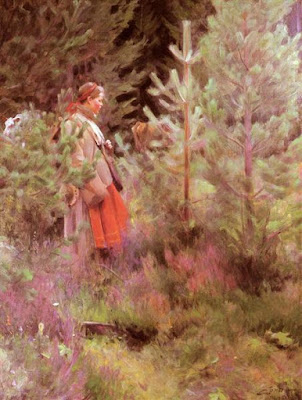Apparently, I’ve been doing nocturnes all wrong.
 |
| S’mores (Ben and Cora at Rollins Pond), by Carol L. Douglas, 9X12, oil on canvasboard. It’s difficult to photograph a wet nocturne. |
Like a good farmer, my bedtime is 7:30. Most of the year, that makes painting nocturnes difficult. They only work in December, when the sun sets at 4 PM at my little snug harbor. Otherwise, I’m tired and fractious when I paint them, and that shows.
This year, there’s a full moon during
Adirondack Plein Air. Even I could see the advantages of staying up.
Chrissy Pahucki and I had one of those Great Ideas that so often gets me in trouble. She secured a campsite in the state forest. I got the makings for
S’Mores. We met at dusk.
 |
| The cycle of life (Black Pond), by Carol L. Douglas, 14X18, oil on canvasboard. |
It killed me to pay $5 for a bag of spruce logs when I have about ten cords of hardwood behind my shed. However, the ban on moving firewood applies even to artists. I felt a little better buying it from
Paul Smith’s College VIC. I’d like to think I was supporting their athletics program, since the wood is split by their students.
“How about getting hot dogs to roast for dinner?” I suggested. Fifteen-year-old Ben rolled his eyes at me, as if I were an elderly, daft grandmother. I counted on my fingers. Yes, I was old enough, with room to spare. I cackled, since it seemed appropriate.
 |
| Beaver dam, by Carol L. Douglas, 14X18, oil on canvasboard. A special thank you to Sandra Hildreth, who took me to this wonderful place. |
Cora, 14, has started to look startlingly like her dad, although much prettier. She has a lovely profile and is a good model. I made a mental note to have her pose for a real portrait next year.
We talked about important stuff, such as whether Ben could toast a marshmallow without catching it on fire.
Beth Bathe concentrated on the back of Cora’s head, while
Lisa BurgerLentz ignored us all and went down to the shore and painted the waning light across
Rollins Pond.
The moon rose, magnificent above a Winnebago parked nearby. “Wow, this is beautiful!” exclaimed Chrissy, who’d wandered off and was standing at the shoreline. We trooped down and admired the view, which was, of course, spectacular. The pond was so still that the stars were reflecting in its surface. A light froth of cirrocumulus clouds arced above our heads, and simultaneously, at our feet. The moon, huge and wise, peeked through the needles of an Eastern White Pine.
 |
| The view that got away. I stood in the water to take this photo, and now my shoes are wet and cold. |
It was, of course, the better scene, one in a million, and we’d let it get away from us. That’s always the way, it seems. I try to be philosophical and tell myself that’s the sign of a great painting location.
We had the campsite until 11 AM. Could I stay and paint another nocturne? The late hour eventually won out. This morning I feel like I’ve been on a three-day toot, which is why this post is late and barely intelligible. But I learned something important about nocturnes: they’re much more fun if you do them by a fire with friends.











